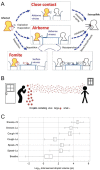Detecting COVID-19 from Breath: A Game Changer for a Big Challenge
- PMID: 33825440
- PMCID: PMC8043202
- DOI: 10.1021/acssensors.1c00312
Detecting COVID-19 from Breath: A Game Changer for a Big Challenge
Abstract
Coronavirus disease 2019 (COVID-19) is probably the most commonly heard word of the last 12 months. The outbreak of this virus (SARS-CoV-2) is strongly compromising worldwide healthcare systems, social behavior, and everyone's lives. The early diagnosis of COVID-19 and isolation of positive cases has proven to be fundamental in containing the spread of the infection. Even though the polymerase chain reaction (PCR) based methods remain the gold standard for SARS-CoV-2 detection, the urgent demand for rapid and wide-scale diagnosis precipitated the development of alternative diagnostic approaches. The millions of tests performed every day worldwide are still insufficient to achieve the desired goal, that of screening the population during daily life. Probably the most appealing approach to consistently monitor COVID-19 spread is the direct detection of SARS-CoV-2 from exhaled breath. For instance, the challenging incorporation of reliable, highly sensitive, and cost-efficient detection methods in masks could represent a breakthrough in the development of portable and noninvasive point-of-care diagnosis for COVID-19. In this perspective paper, we discuss the critical technical aspects related to the application of breath analysis in the diagnosis of viral infection. We believe that, if achieved, it could represent a game-changer in containing the pandemic spread.
Keywords: COVID-19; VOCs; breath; detection; diagnostics; sensor; virus; volatile organic compounds.
Conflict of interest statement
The authors declare no competing financial interest.
Figures





References
MeSH terms
LinkOut - more resources
Full Text Sources
Other Literature Sources
Medical
Miscellaneous

